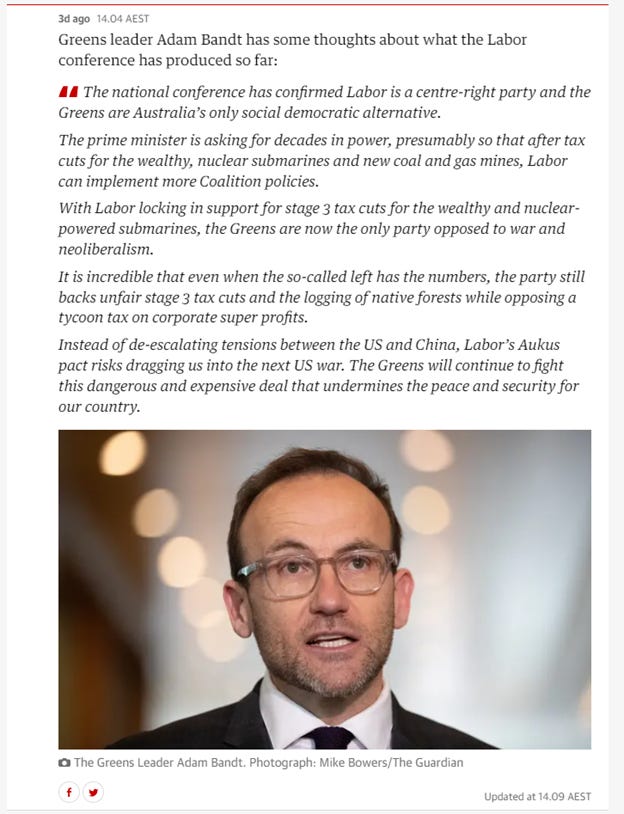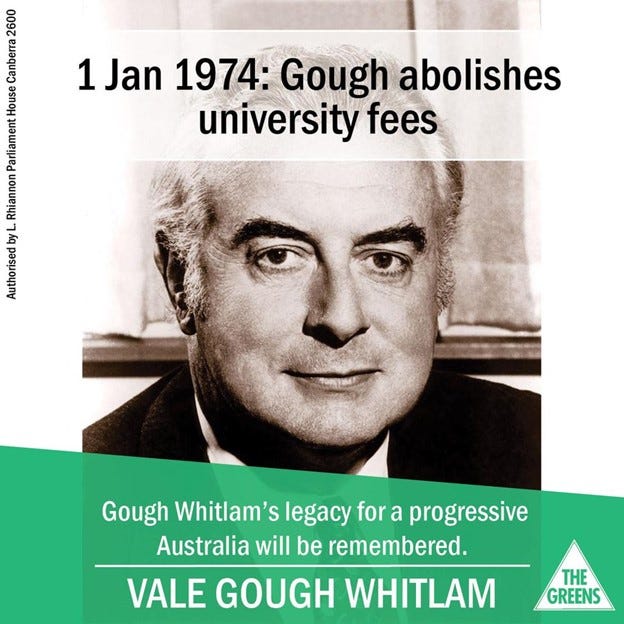During Labor’s 2023 national conference I was struck a quote from Australian Greens Party leader Adam Bandt claiming that the ALP is a “centre right” party, and that his party is the “only social democratic alternative.”
Bandt has repeatedly made this argument during his leadership, and even before.
This is an important indication of how Bandt is seeking to position the Greens party against Labor.
The statement itself is a political legerdemain – an attempt to position Labor outside of its own tradition of progressive reform, and to depict the Greens party as the inheritors of this tradition.
We have seen this before.
You might remember the controversy in 2014 when the Greens party circulated a meme of Whitlam immediately after his death badged with a Greens logo.
Then-NSW Greens party convenor Hall Greenland subsequently wrote an article for Crikey titled: “‘Suck it up, comrades’: young Whitlam would have been a Green today”
The piece quite literally sought to put words in the deceased Whitlam’s mouth.
Even more concerningly, it demonstrated a complete lack of awareness of Whitlam’s Labor-oriented reform project, his deep and lifelong commitment to the party, and his fealty to the broader movement of labour from which the ALP emerged.
But it was revealing as to the manner in which a section of the Greens party has sought to position itself as the inheritor of Labor’s reforming tradition: “The rise of the Greens is partly an expression of this; they have occupied the ground that post-Whitlam Labor vacated to its Left.”
In a less ghoulish example, upon his election as the first Greens Party Senator in Victoria in 2010, Richard Di Natale exclaimed: “There is a new light on the hill and it's powered by renewable energy.”
This is not simple trolling.
The Greens party clearly understands the power of history.
History is not just a bunch of stuff that happened once. A political party’s history is the core of its identity, its values, and its mission.
A party’s historic accomplishments are a record it stands on – it imbues its claims with credibility (or demonstrates their falsity).
Labor will allow the Greens to appropriate its reforming record at its own peril.
What motivates this attempted hijack of Labor’s historical legacy?
The most obvious answer, though an unkind one, would be that it is because the Greens party has so little history of its own.
In a general sense though, of course, this would not be true. While it delights in declamations against the “old parties”, the Greens party is hardly some neophyte to the world of institutional politics
.
Debate rages as to the actual origins of the Greens party. But if we go by the official history on the Australian Greens party website: “The United Tasmania Group was the first 'green' party anywhere in the world and ran candidates in the 1972 election.”
51 years is hardly “new”.
The Greens party does have a history – but predominantly as a protest group congealing into a party form and entering parliament. Its trajectory since then has been of steady consolidation of its place within the senate, and some clear success in inner-city electorates in state and now the federal lower houses.
But what it lacks is a substantial history of achieving progressive transformation through government.
Declamations against the “old parties” and attacking Labor policies for not going far enough is all well and good for the stripping of progressive votes from Labor and continuing to appeal to younger voters who are disaffected from the world of institutional politics (and the compromises the structure of the democratic system necessitates).
But what it does not do is position the Greens party as a viable alternative capable of utilising government to actually achieve something.
Lacking this type of history of its own, the Greens party seeks to appropriate Labor’s reforming record by placing itself in the social democratic tradition of the ALP, and claiming that Labor has abandoned its own past.
Bandt’s role as leader is particularly interesting here.
The Greens party is historically one of many factions united under a broad rubric. The official Greens line used to be that it was a party of “neither left nor right” and it accommodated radicals, what is often seen as a centre left, and moderates (usually predominantly motivated by environmental issues). Its politics were generally perceived to be ‘post-material’, based on the completely erroneous notion that affluence had reduced the significance of class-based political claims in the twenty-first century.
The NSW branch used to be noted for its radical inheritance from the social movements of the 1980s, though a new generation has tempered that somewhat.
Bandt was always on the left of the moderate Victorian branch – but he was never a radical in the NSW mould. He has always had a clearer sense of the importance of economic inequality as a mobilising issue. While disagreeing with much of his political approach, I think it is important to recognise that his underlying convictions are genuine. He is also a cannier political operator than he is often given credit for.
His leadership has notably coincided with the growth of a more leftist section of the party in Queensland – important nationally due to the party’s success in Brisbane.
For Bandt, claiming the social democratic mantle both helps define what he wants the Greens to be under his leadership (useful in the internal contest over the party’s mission and ambitions) as well as defining his broader political positioning of the Greens party in relationship to Labor.
The Greens party’s primary aim in the short to medium term is not to win the centre to form majority government.
Take Bandt’s address to the Greens party’s December 2022 National conference, adapted for his website.
Bandt outlined the party’s ambition for the anticipated 2025 election:
“If we prepare now, we will be able to hold our own in the face of pressure from the government, but we’ll be able to match what we do in Parliament with what people hear on the ground, and we could well end up with not just four seats in the House, but 8 or 12 or more.”
Labor would sneer at this prospect (mathematically, where are these seats coming from?) at its own peril.
What the Greens party is effectively seeking is the shake up of the Australian parliamentary system, so that it more closely resembles the coalitionist politics of Europe. Its leaders have articulated this clearly many times before.
The logic is simple: if the Greens party can attract enough of Labor’s historic vote, alongside new generations of progressive-inclined voters (predominantly a section of younger voters), then it can potentially accumulate a substantial enough vote to force itself into coalition government even while falling well short of a majority.
The Greens party is aware that it lacks a substantive legacy of progressive reform of its own to justify a place in minority government.
So it is seeking to position itself as a kind of inheritor to the centre left tradition of the ALP as part of this project to attract Labor voters (and ex voters).
How can Labor defend its historical legacy?
The best way for Labor to combat this attempted hijack is by continuing to be a positive and forward-looking government that responds to the organic needs of the electorate with policy that will make a real difference.
This needs to be backed up with effective communication about Labor achievements in this government that include a process of educating the electorate on the substantial barriers to achieving policy outcomes, and assurance of how Labor will work through these to deliver measurable results that will improve the lives of everyday citizens.
Such an approach will be more effective than the political slanging match that the Greens party have been goading Labor into, especially on housing.
An important part of this will be Labor drawing on its historical legacy to articulate its meaning and purpose in government. To show that Labor governments are about achieving serious and lasting reform – but also educating on the reality of how difficult this can be.
Labor’s history is filled with examples on how achieving change through government is about more than stating what you want and then criticising everyone from the sidelines if you don’t get it straight away.
The Greens party has been learning lessons from Labor’s history – it is vital that the modern ALP does the same.
If you agree, please help share the word about this substack newsletter. Maintain Your Rage is filled with history for the True Believers. Please share with your networks.







